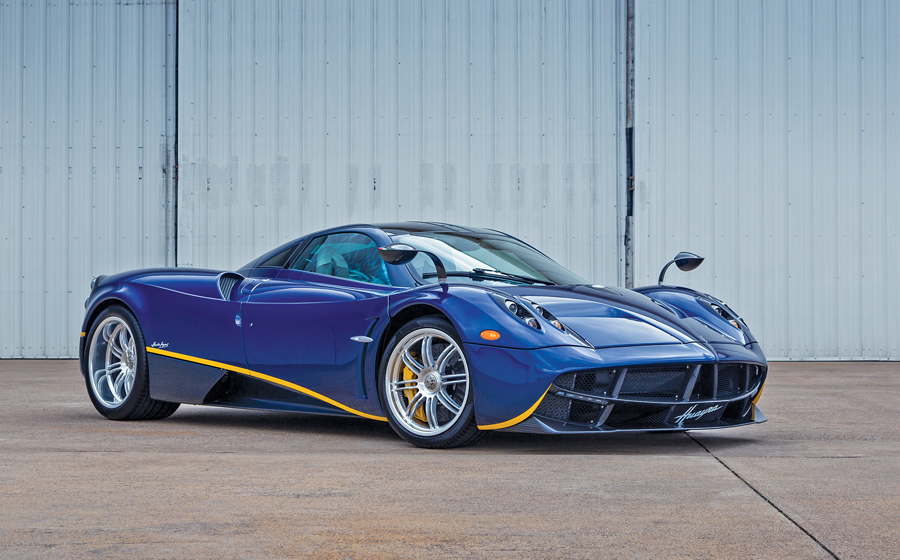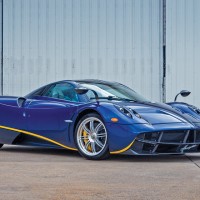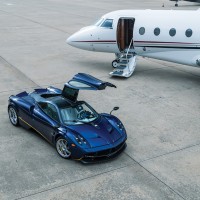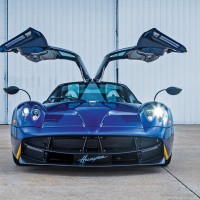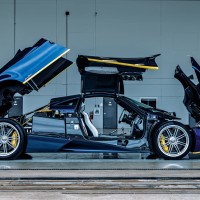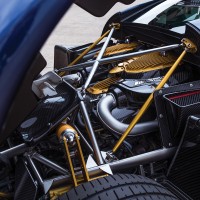- Less than 400 miles from new
- Over $260,000 in options, including $20,000 seven-piece luggage set
- Horacio Pagani’s second masterpiece of engineering, design and Italian craftsmanship
SCM Analysis
Detailing
| Vehicle: | 2014 Pagani Huayra |
| Years Produced: | 2011–present |
| Number Produced: | 100 |
| Original List Price: | $1,653,240 |
| SCM Valuation: | Median to date, $2,035,000 (this car is the only Huayra sold at auction); high sale: $2,035,000 (this car). |
| Tune Up Cost: | $5,000 |
| Club Info: | Pagani hosts their own events for owners and interested clients at least once a year at an annual meet called Vanishing Point, which normally takes place somewhere in Italy |
| Website: | http://www.pagani.com |
| Alternatives: | 2012 Bugatti Veyron 16.4 Super Sport, 2015 McLaren, 2015 Porsche 918 |
| Investment Grade: | A |
This car, Lot 164, sold for $2,035,000, including buyer’s premium, at RM Sotheby’s auction in Amelia Island, FL, on March 12, 2016.
“The hardest part for us is to give a form to our dreams. Every detail has to be perfect, has to be something worthy to stand alone.” — Horacio Pagani
The Pagani Huayra (pronounced why-ra) is one of the best supercars of all time. In fact, it’s a hypercar — a hand-built machine in a league of its own.
Named for the Incan god of wind, the Huayra is the epitome of modern aerodynamic beauty, with its ultra-wide stance, teardrop cockpit and sleekly arched fenders. It competes with the gold-standard Bugatti Veyron and the outlandish Koenigseggs.
Pagani is an exclusive and bespoke operation that makes fewer than 40 cars per year. With instrument bezels hand-carved from blocks of aircraft-quality aluminum, a unique system of ailerons that glue the car to the road at racetrack speeds — and even a key fob that’s a beautifully sculpted alloy model of the Huayra itself — this car is a work of master craftsmanship and singular design.
One man’s vision
There’s an extraordinary person behind this masterpiece of a car. Horacio Pagani, modern Renaissance man, is an Argentine-born self-taught engineer and musician who eschews computers and worships Leonardo Da Vinci. As a child, Pagani built dream cars from balsa wood. Today as founder and leader of Pagani Automobili, he is a passionate perfectionist. As a result, the Huayra is the most meticulously crafted car on the planet.
Pagani was an early pioneer in the use of carbon fiber in exotic cars. He worked for Lamborghini and founded Modena Design, which has developed lightweight composite components for Renault, Ferrari, Dallara, and Aprilla. The Huayra’s sculpted bodywork is a showcase of 15 different kinds of carbon fiber, some of which is blended with titanium. All of these alloys are aerospace-grade.
Outlandish specs
The Huayra has all kinds of requisite supercar bling: quad headlights, gullwing doors, muscular lines with multiple high-profile air intakes, a whopping V12 AMG powerplant and a sumptuous skin handmade in Modena. The car also has active aerodynamics inspired by aircraft wing flaps. (These computer-controlled ailerons are stealthily installed on all four corners of the car. Depending on speed and lateral acceleration, the flaps automatically and independently raise and lower to provide downforce, reduce drag or control body roll.) And the Huayra can be totally custom-configured. The sky-is-the-limit options list includes a set of luggage that puts Louis Vuitton to shame.
Pagani makes use of specialized outside suppliers that represent a Who’s Who of the global parts bin: wheels from APP, interior pieces machined by ASPA, Carbon-Ceramic brakes by BSCCB (the joint venture between Brembo and SGL Group), a titanium exhaust system by MHG, ultra-wide Pirelli P Zero tires, and interior “sustainable” leather from the Dani Group.
Mercedes-AMG supplies the custom-built 720-hp, 6.0-liter twin-turbo V12, which delivers 738 pound-feet of torque through a 7-speed single-clutch transmission, catapulting the Huayra from zero to 60 in three seconds and topping out at 228 mph.
Too cool for depreciation?
This car, made in 2014, is number 62 of just 100. It has less than 400 miles on the odometer, so it is basically a brand-new car. What’s more, this car sold at a hammer price of $1,850,000. That’s just a hair off the new list price of just under $2 million.
Has this over-the-top hypercar blown past depreciation? It’s hard to say, as so few exist. Right now, this is the only Pagani Huayra in SCM’s Platinum Auction Database — we have records of five Pagani Zonda sales — so there isn’t enough of a sample to make any kind of a reasonable statement.
That said, I think the Pagani has serious legs and will at least keep depreciation at bay — and end up appreciating over time.
Remember, we have a lot of new, younger players in the market right now, and many of them want state-of-the-art modern supercars. The Huayra more than fits their desires.
Even if you prefer Brass Era cars or Duesenbergs, it’s hard not to respect the Huayra. This is not just another expensive four-wheeled bauble.
While Pagani himself lacks Enzo Ferrari’s racing background, his passion for innovation and craftsmanship gives the Huayra a pedigree of unmatched quality — far beyond supercar flash. Pagani describes his customers as “low-profile, humble, passionate about cars but passionate about art in general.” He says, “A lot of them have the same stories, starting from zero and reaching their goals.”
The company is moving and upgrading its factory, with the goal of building 50 cars per year. However, only 100 Huayras will be made — and every one is spoken for. ♦
(Introductory description courtesy of RM Sotheby’s.)
